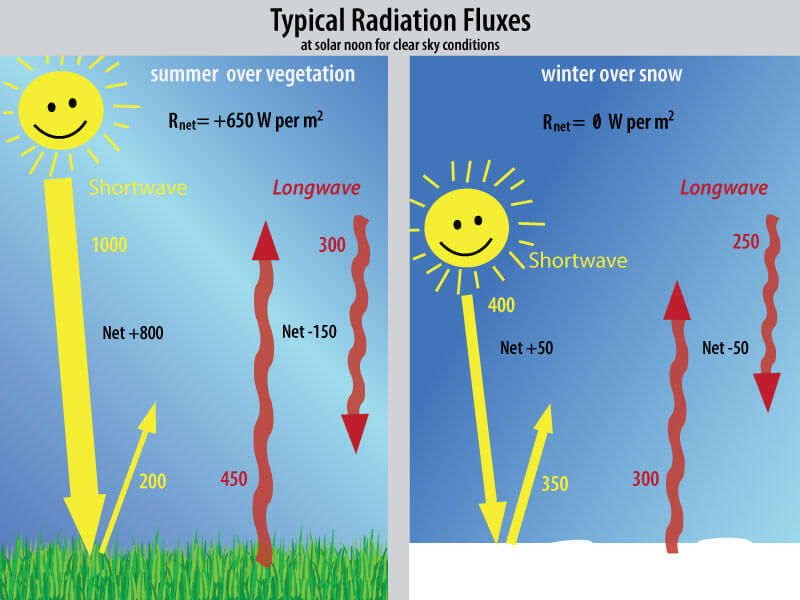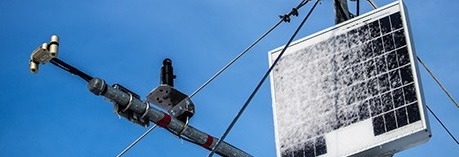Free shipping in the US for orders over $475.

Net radiation at Earth's surface is the source of available energy that drives key processes, including surface and atmospheric heating, evaporation, sublimation, and transpiration. Shortwave radiation (approximately 280 to 4000 nm) is emitted by the sun, and a fraction incident at Earth's surface is reflected. Longwave radiation (approximately 4000 to 100,000 nm) is emitted by molecules in the atmosphere and land surfaces. Net radiation is the difference between incoming (downwelling) and outgoing (upwelling) shortwave and longwave radiation. Net radiation at Earth's surface is spatially and temporally variable due to changes in position of the sun with respect to Earth's surface, changes in atmospheric conditions, and differences in land surface conditions. Shortwave radiation accounts for a larger proportion of net radiation during the day when the sun is shining. Longwave radiation contributes to net radiation during the day and at night.
Typical values of the four components of net radiation (Rnet) for a clear summer day near solar noon over vegetation and a clear winter day near solar noon over snow are shown in the figure below (all unites are W m-2). Net shortwave radiation is the difference between incoming shortwave (from sun, SWi) and outgoing shortwave (reflected by surface, SWo). Net longwave radiation is the difference between incoming longwave (emitted by molecultes in the atmosphere, LWi) and outgoing longwave (emitted by elements at the surface, LWo). Net radiation is the sum of net shortwave and net longwave radiation. Net radiation changes with solar zenith angle, atmospheric conditions (e.g., degree of cloudiness), and surface conditions (e.g., bare soil, plant cover, snow).

Apogee Instruments model SN-500 net radiometers are four-component instruments, with individual upward- and downward-looking pyranometers and pyrgeometers. Each radiometer consists of a thermopile detector and filter mounted in an anodized aluminum housing. Each radiometer is heated to minimize the effects of dew, frost, snow, and ice on the filter and sensor head. Analog signals from each radiometer are measured with an onboard voltmeter and converted to SDI-12 outputs, eliminating the need for multiple analog datalogger channels to make the four-component measurement of net radiation. SN-500 net radiometers are small and lightweight to facilitate rapid and simple mounting.
| SN-500 | SN-522 | |
|---|---|---|
| Input Voltage Range | 5.5 to 24 V DC (heaters are optimized to run at 12 V DC) | 5.5 to 24 V DC (heaters are optimized to run at 12 V DC) |
| Output Type | SDI-12 | Modbus |
| Current Draw (12 V DC Supply Voltage) | Heaters on, communication enabled: 63 mA; Heaters off, communication enabled: 1.5 mA; Heaters off, communication disabled: 0.6 mA | Heaters on: 72 mA; Heaters off: 13.5 mA |
| Response Time | 1 s (SDI-12 data transfer rate; detector response times are 0.5 s) | It takes 750 ms to digitize all detector signals |
| Heaters (sensors individually heated) | 62 mA current draw and 740 mW power requirement at 12 V DC | 62 mA current draw and 740 mW power requirement at 12 V DC |
| Operating Environment | -50 to 80 C; 0 to 100 % relative humidity | -50 to 80 C; 0 to 100 % relative humidity |
| Dimensions | 116 mm length, 45 mm width, 66 mm height | 116 mm length, 45 mm width, 66 mm height |
| Mass | 320 g (with mounting rod and 5 m of lead wire) | 320 g (with mounting rod and 5 m of lead wire) |
| Cable | M8 connector (IP68 rating) to interface to sensor housing; 5 m of four conductor, shielded, twisted-pair wire with a TPR jacket; pigtail lead wires | M8 connector (IP68 rating) to interface to sensor housing; 5 m of four conductor, shielded, twisted-pair wire with a TPR jacket; pigtail lead wires |
| Pyrgeometer Specifications | ||
| Sensitivity | 0.12 mV per W m-2 (variable from sensor to sensor, typical value listed) | 0.12 mV per W m-2 (variable from sensor to sensor, typical value listed) |
| Calibration Factor (Reciprocal of Sensitivity) | 8.5 W m-2 (variable from sensor to sensor, typical value listed) | 8.5 W m-2 (variable from sensor to sensor, typical value listed) |
| Calibration Uncertainty | ± 5 % | ± 5 % |
| Output Ranges | -24 to 24 mV | -24 to 24 mV |
| Measurement Range | -200 to 200 W m-2 (net longwave irradiance) | -200 to 200 W m-2 (net longwave irradiance) |
| Measurement Repeatability | Less than 1 % | Less than 1 % |
| Long-term Drift | Less than 2 % change in sensitivity per year | Less than 2 % change in sensitivity per year |
| Non-linearity | Less than 1 % | Less than 1 % |
| Detector Response Time | Less than 0.5 s | Less than 0.5 s |
| Field of View | 150° | 150° |
| Spectral Range | 5 to 30 µm | 5 to 30 µm |
| Temperature Response | Less than 5 % from -15 to 45 C | Less than 5 % from -15 to 45 C |
| Window Heating Offset | Less than 10 W m-2 | Less than 10 W m-2 |
| Zero Offset B | Less than 5 W m-2 | Less than 5 W m-2 |
| Tilt Error | Less than 0.5 % | Less than 0.5 % |
| Uncertainty in Daily Total | ± 5 % | ± 5 % |
| Temperature Sensor | 30 kΩ thermistor, ± 1 C tolerance at 25 C | 30 kΩ thermistor, ± 1 C tolerance at 25 C |
| Output from Thermistor | 0 to 2500 mV (typical, other voltages can be used) | 0 to 2500 mV (typical, other voltages can be used) |
| Input Voltage Requirement for Thermistor | 2500 mV excitation (typical, other voltages can be used) | 2500 mV excitation (typical, other voltages can be used) |
| Pyranometer Specifications | ||
| Sensitivity | 0.045 mV per W m-2 (upward-looking); 0.15 mV per W m-2 (downward-looking); (variable from sensor to sensor, typical values listed) | 0.035 mV per W m-2 (upward-looking); 0.15 mV per W m-2 (downward-looking); (variable from sensor to sensor, typical values listed) |
| Calibration Factor (Reciprocal of Sensitivity) | 22 W m-2 per mV (upward-looking); 6.7 W m-2 per mV (downward-looking); (variable from sensor to sensor, typical values listed) | 28.5 W m-2 per mV (upward-looking); 6.7 W m-2 per mV (downward-looking); (variable from sensor to sensor, typical values listed) |
| Calibration Uncertainty | Less than 3 % at 1000 W m-2 | Less than 3 % at 1000 W m-2 |
| Output range | 0 to 90 mv (upward-looking); 0 to 300 mV (downward-looking) | 0 to 70 mv (upward-looking); 0 to 300 mV (downward-looking) |
| Measurement Range | 0 to 2000 W m-2 (net shortwave irradiance) | 0 to 2000 W m-2 (net shortwave irradiance) |
| Measurement Repeatability | Less than 1 % | Less than 1 % |
| Long-term Drift | Less than 2 % per year | Less than 2 % per year |
| Non-linearity | Less than 1 % | Less than 1 % |
| Detector Response Time | 0.5 s | 0.5 s |
| Field of View | 180° (upward-looking); 150° (downward-looking) | 180° (upward-looking); 150° (downward-looking) |
| Spectral Range | 385 nm to 2105 nm (upward-looking), 295 nm to 2685 nm (downward-looking); (50 % points) | 385 nm to 2105 nm (upward-looking), 295 nm to 2685 nm (downward-looking); (50 % points) |
| Directional (Cosine) Response | Less than 30 W m-2 at 80° solar zenith (upward-looking); Less than 20 % for angles between 0 and 60° (downward-looking) | Less than 30 W m-2 at 80° solar zenith (upward-looking); Less than 20 % for angles between 0 and 60° (downward-looking) |
| Temperature Response | Less than 5 % from -15 to 45 C | Less than 5 % from -15 to 45 C |
| Zero Offset A | Less than 5 W m-2; Less than 10 W m-2 (heated) | Less than 5 W m-2; Less than 10 W m-2 (heated) |
| Zero Offset B | Less than 5 W m-2 | Less than 5 W m-2 |
| Uncertainty in Daily Total | Less than 5 % | Less than 5 % |
Net Radiometer Introduction
If you can't access the video via Youtube, click here.
Principles of Net Radiation
If you can't access the video via Youtube, click here.
Lecture 5-Net Radiation
Net radiation is a key variable in the surface energy balance and influences turbulent fluxes, including evapotranspiration.
Applications include measurements on flux towers and weather stations.






If you would like to share your application of this product, please click here
Net Radiometer Comparison Data
Solar, Net, and Photosynthetic Radiation - ASA Agroclimatology
Feature article on the Net Radiometer in Meteorological Technology International
Evaluation of Measurement accuracy and comparison of two new and three traditional net radiometers
Does the net radiometer give individual measurements from each pyranometer and pyrgeometer?
Yes, the sensors provide individual measurements of all four components of net radiation
Can I order longer cable lengths for my sensor?
Please contact Apogee for custom cable lengths.
Programs are in .CR1X format and can be downloaded for use with Campbell Scientific dataloggers. Right click and select "Save target as..." or an equivalent command in your browser. They can also be viewed using Wordpad or other text viewers.
Note: In 2020 the CR1000 Campbell Scientific datalogger was discontinued. Click here to access the discontinued .CR1 format sample datalogger programs >